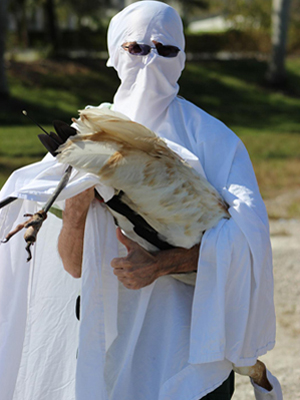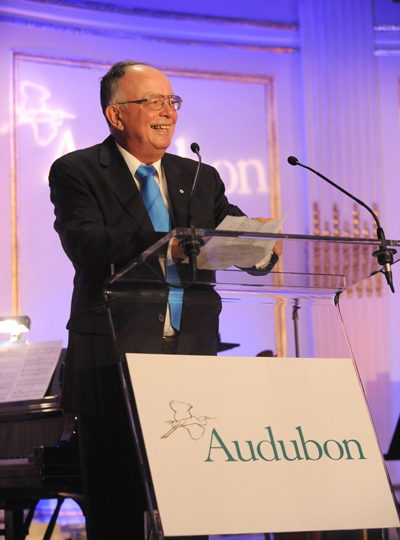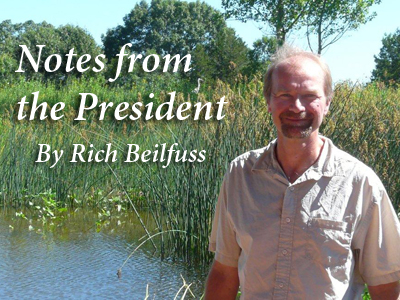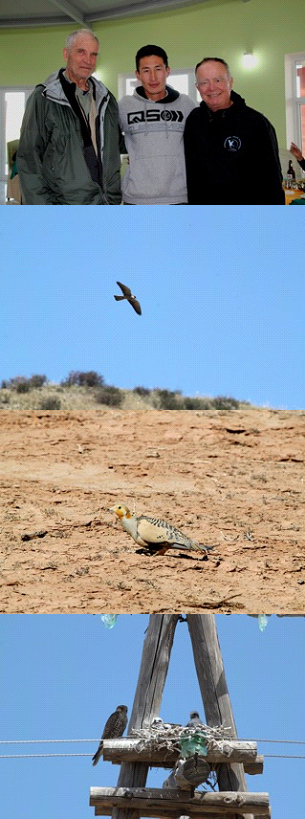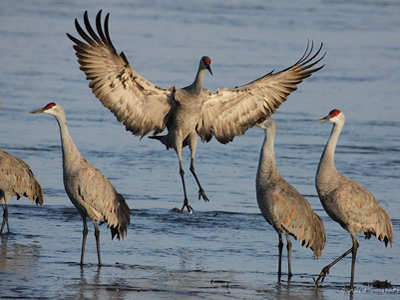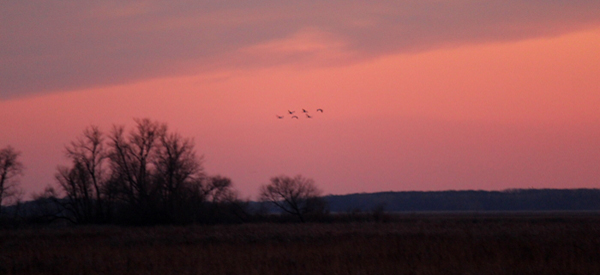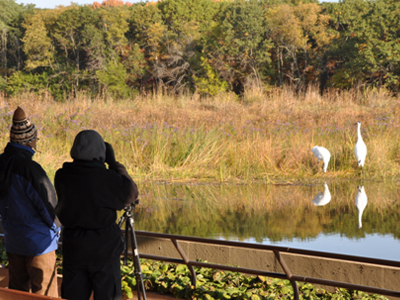 On Saturday, January 26th, Jeanette Parker was outside a subdivision bordering the Everglades in south Florida. Jeanette, who had previously worked for the Florida Fish & Wildlife Conservation Commission (FFWCC) on a project to reintroduce non-migratory Whooping Cranes to Florida, had found herself back in the field, but this time she was trying to capture an eastern migratory crane that had an injury.
On Saturday, January 26th, Jeanette Parker was outside a subdivision bordering the Everglades in south Florida. Jeanette, who had previously worked for the Florida Fish & Wildlife Conservation Commission (FFWCC) on a project to reintroduce non-migratory Whooping Cranes to Florida, had found herself back in the field, but this time she was trying to capture an eastern migratory crane that had an injury.
Author: Sara
Audubon Gala Honors Leading Conservationists with Top Environmental Awards
 Riding on Bette Midler’s wings, The National Audubon Society soared last night, Jan. 17, at the Plaza Hotel in New York. For the first time, the organization awarded two of the nation’s most prestigious environmental honors on the same night: the inaugural Dan W. Lufkin Prize for Environmental Leadership and the Audubon Medal.
Riding on Bette Midler’s wings, The National Audubon Society soared last night, Jan. 17, at the Plaza Hotel in New York. For the first time, the organization awarded two of the nation’s most prestigious environmental honors on the same night: the inaugural Dan W. Lufkin Prize for Environmental Leadership and the Audubon Medal.
George Archibald, co-founder of the International Crane Foundation, received the first Lufkin Prize and its $100,000 award, and philanthropist Louis Bacon received the esteemed Audubon Medal.
Notes from the President
 When I think about the conservation challenges we face in the coming century, my thoughts invariably turn to food, water, and energy. How will we feed 9 billion people and still maintain healthy landscapes for cranes and other life we hold dear? How will we water thirsty cities and farmlands without sacrificing life-supporting rivers and wetlands? Can we meet the global demand for electricity without devastating our land, water, air…and climate?
When I think about the conservation challenges we face in the coming century, my thoughts invariably turn to food, water, and energy. How will we feed 9 billion people and still maintain healthy landscapes for cranes and other life we hold dear? How will we water thirsty cities and farmlands without sacrificing life-supporting rivers and wetlands? Can we meet the global demand for electricity without devastating our land, water, air…and climate?
Siberian Cranes Engender Cornell Friendships
 Our friendship began in the spring of 1977 when Ted, then US Ambassador to Afghanistan, helped Ron Sauey, co-founder with George of the International Crane Foundation, find the stopping point in Afghanistan of a flock of Siberian Cranes migrating from northern India to northern Siberia. The friendship has been renewed many times since 1977, most recently when George discovered a Siberian Crane and told Ted where to find it at the Gun Gaalut Reserve east of Ulaanbaater in June, 2012. We met at our ger (yurt) camp on the first night of George’s trip to eastern Mongolia and the last night of a two-week trip Ted was taking in the same area where he had not yet found any Siberian Cranes.
Our friendship began in the spring of 1977 when Ted, then US Ambassador to Afghanistan, helped Ron Sauey, co-founder with George of the International Crane Foundation, find the stopping point in Afghanistan of a flock of Siberian Cranes migrating from northern India to northern Siberia. The friendship has been renewed many times since 1977, most recently when George discovered a Siberian Crane and told Ted where to find it at the Gun Gaalut Reserve east of Ulaanbaater in June, 2012. We met at our ger (yurt) camp on the first night of George’s trip to eastern Mongolia and the last night of a two-week trip Ted was taking in the same area where he had not yet found any Siberian Cranes.
Conviction in January 2012 Whooping Crane Shooting
 ICF was pleased to learn of the recent sentencing of two men convicted of shooting an eastern migratory Whooping Crane in January 2012. A Whooping Crane released in 2008, part of a nesting pair, was shot and killed by John Burke and Jason McCarter in Knox County, Ind. A citizen tip led to charges against McCarter and Burke. The two men pled guilty and were sentenced on November 21.
ICF was pleased to learn of the recent sentencing of two men convicted of shooting an eastern migratory Whooping Crane in January 2012. A Whooping Crane released in 2008, part of a nesting pair, was shot and killed by John Burke and Jason McCarter in Knox County, Ind. A citizen tip led to charges against McCarter and Burke. The two men pled guilty and were sentenced on November 21.
Travels with George: North Korea Fall 2012
 The following are notes from my October 27-November 8, 2012 visit to North Korea. I was the guest of North Korea’s foremost ornithologist, Dr. Park U Il of the State Academy of Sciences (SAOS), with whom ICF has been working since my first visit in 2008. From our base at the Pyongyang Hotel, we traveled to three important sites for Red-crowned Cranes.
The following are notes from my October 27-November 8, 2012 visit to North Korea. I was the guest of North Korea’s foremost ornithologist, Dr. Park U Il of the State Academy of Sciences (SAOS), with whom ICF has been working since my first visit in 2008. From our base at the Pyongyang Hotel, we traveled to three important sites for Red-crowned Cranes.
ICF Helps Protect Sandhill Crane Wintering Area in Tennessee
 The Land Trust for Tennessee and Tennessee Wildlife Resources Agency (TWRA) successfully partnered to purchase 68 acres of critical wildlife habitat located along Blythe Ferry Road near the confluence of the Hiwassee and Tennessee Rivers. This essential acreage is now part of the Hiwassee Wildlife Refuge in Meigs County thanks to the tremendous support of individuals, foundations and the community.
The Land Trust for Tennessee and Tennessee Wildlife Resources Agency (TWRA) successfully partnered to purchase 68 acres of critical wildlife habitat located along Blythe Ferry Road near the confluence of the Hiwassee and Tennessee Rivers. This essential acreage is now part of the Hiwassee Wildlife Refuge in Meigs County thanks to the tremendous support of individuals, foundations and the community.
Ultralight-led Whooping Cranes Arrive at Wintering Destination
 Five endangered Whooping Cranes arrived Friday on their wintering grounds at St. Marks National Wildlife Refuge (NWR) in Wakulla County, Florida. These cranes are the 12th group to be guided by ultralight aircraft from central Wisconsin to the Gulf coast of Florida.
Five endangered Whooping Cranes arrived Friday on their wintering grounds at St. Marks National Wildlife Refuge (NWR) in Wakulla County, Florida. These cranes are the 12th group to be guided by ultralight aircraft from central Wisconsin to the Gulf coast of Florida.
DAR Whooping Cranes Begin Fall Migration
 Six young Whooping Cranes were released Monday at Horicon National Wildlife Refuge (NWR) in Dodge County, Wis. The cranes are part of the Direct Autumn Release (DAR) project conducted by the Whooping Crane Eastern Partnership (WCEP), an international coalition of public and private organizations that is reintroducing this highly imperiled species in eastern North America, part of its historic range.
Six young Whooping Cranes were released Monday at Horicon National Wildlife Refuge (NWR) in Dodge County, Wis. The cranes are part of the Direct Autumn Release (DAR) project conducted by the Whooping Crane Eastern Partnership (WCEP), an international coalition of public and private organizations that is reintroducing this highly imperiled species in eastern North America, part of its historic range.
Omega and Seurat Help Researchers Study Crane Energy Use
 As the seasons change, so do the patterns and behaviors of our captive flock. Things have been busy this fall within the Whooping Crane enclosure at ICF. We recently hosted Ph.D. student Megan Fitzpatrick, who spent a week here in Baraboo watching our Whooping Cranes, Omega and Seurat, and studying their behavior in a wetland environment.
As the seasons change, so do the patterns and behaviors of our captive flock. Things have been busy this fall within the Whooping Crane enclosure at ICF. We recently hosted Ph.D. student Megan Fitzpatrick, who spent a week here in Baraboo watching our Whooping Cranes, Omega and Seurat, and studying their behavior in a wetland environment.

